Belarus Tour Guide: Ideas for Your Trip!
Landmarks of Bobruisk: Unique charm of the ‘Jewish capital’ of Belarus
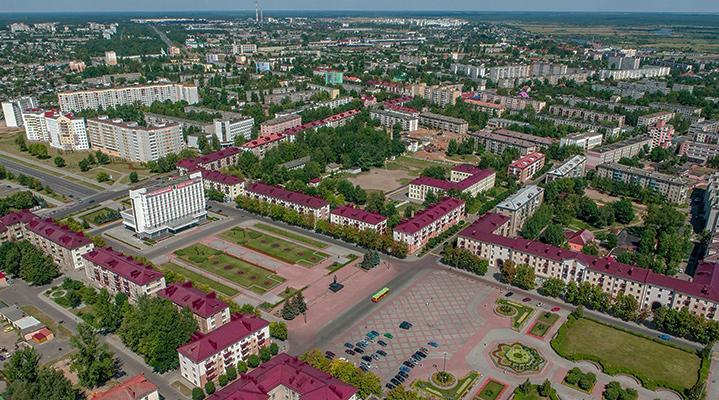
Bobruisk has become widely known far beyond the borders of Belarus thanks to the satirical novel The Little Golden Calf by Ilya Ilf and Evgeny Petrov. The literary "children of Lieutenant Schmidt" were prepared to go to Bobruisk immediately as it was considered ‘a wonderful, highly civilized place’. Today the city welcomes its guests with a bronze sculpture of Shura Balaganov, one of the characters of the novel, the impostor and ‘foster brother’ of the ‘great combinator’ Ostap Bender...
Still, long before the literary fame, the city had a reputation of a truly unique place not only in Belarus but also in Eastern Europe.
The city of Bobruisk, the first mention of which dates back to 1387, is located at the confluence of the Bobruika River into the Berezina. According to one version, the name Bobruisk derives from the Baltic name of the river associated with beavers. Archaeologists say that ancient people lived here as early as the Bronze Age (the end of the 3rd - the beginning of the 2nd millennium BC). The Dregovichi tribe founded their settlement here in the middle of the 1st millennium AD.
The place was first mentioned in Jewish sources in the second quarter of the 16th century. In 1795, Bobruisk acquired the status of a city and became part of The Pale of Settlement which contributed to its population growth. According to the 1897 census, 20,760 Jews lived here accounting for 60% of the total population. The heyday of Jewish life in Bobruisk came at the end of the 19th - early 20th centuries. Among the most sought-after occupations among Jews were clothing manufacture, farm trade, and harvesting and sale of timber.
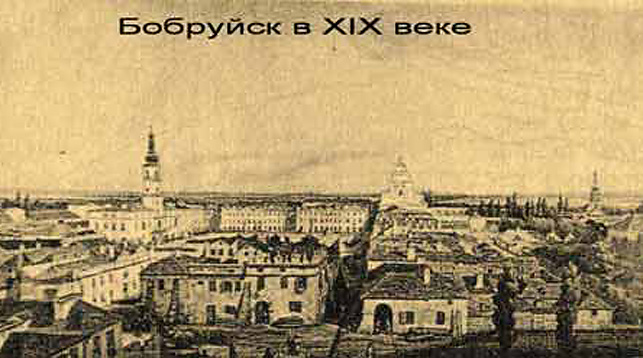
Before World War II, in 1932, 40,000 of the city's 62,000 inhabitants were Jewish. In wartime, due to the inhumane policy of the occupation authorities, 25,000 Jews were killed in the Bobruisk ghetto, which was in existence from 1 August to 20 December 1941. Emigration in the late 1980s and the early 1990s to the United States, Canada, Australia, and Israel also affected the numbers of the city's Jewish community. However, even today Bobruisk is considered the historical, cultural and religious center of Belarusian Jews.
The city is associated with the names of outstanding Bobruisk residents of Jewish origin. Among them are Polina Vengerova, the author of the The Remembrances of a Grandmother novel about the life of a Jewish family in the second half of the 19th century; writer and journalist Mikhail Gerchik; geologist and discoverer of deposits of potassium, stone salts and oil in the Pripyat Trough Zalman Gorelik; the leader of the Zionist labor movement Berl Katznelson; historian Samuel Lozinski; Israeli politician, chairman of the Knesset (1959-1969) Kaddish Luz; author of humorous stories, cartoonist Joseph Tunkel; poet, winner of the Israel Prize for Literature David Shimoni; religious figure, codifier of Jewish conventional law Yechiel Michel Epstein; religious literature publisher Jacob Cohen Ginsburg…
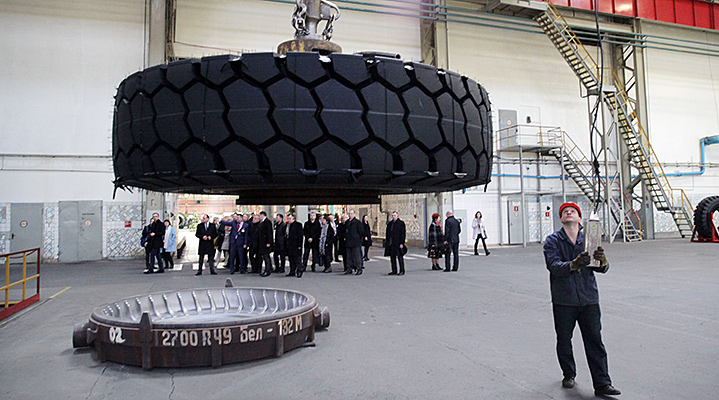
Today Bobruisk is the largest district capital in Belarus with a population of more than 200,000. It is dubbed ‘the city of tire manufacturing’ as it is home to Belshina, one the leading manufacturers of automobile tires in Europe. The city’s famous sweet brand is zefir (including the kosher one) by the Krasny Pischevik confectionery factory. The Jewish culture has had an impact on the architecture of Bobruisk, forming an amazing atmosphere of the Jewish town of the 19th - early 20th centuries.
Pedestrian Sotsialisticheskaya Street
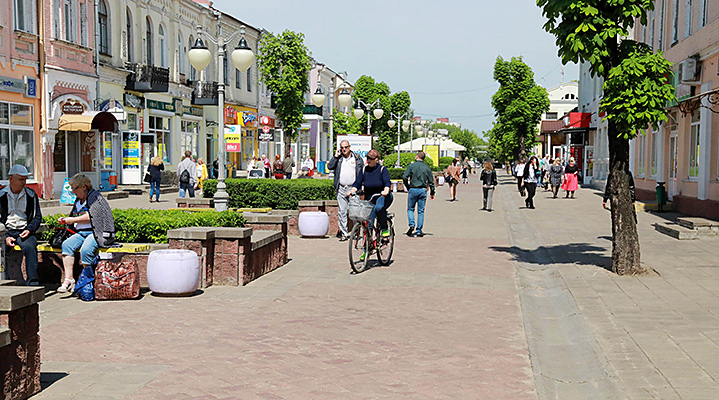
In the heart of the historical Bobruisk there is the car-free Sotsialisticheskaya Street, often dubbed as Bobruisk Arbat and popularly known as Sotsialka. In the early 20th century, it was one of the first cobbled streets of the city and was an ideal place for meetings and long walks. In 1876, it was called Muravyovskaya in honor of Governor General Mikhail Muravyov who suppressed the uprising of 1863-1864. The townspeople called it Nevsky Prospekt as it was home to the city’s wealthiest families and all kinds of shops selling books, haberdashery, jewelry, textiles, wallpaper, food, wine and even wheels.
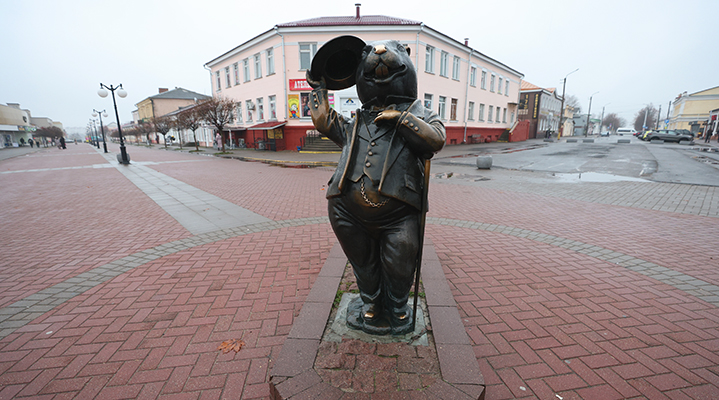
After the ‘old town’ quarter was restored in the 1990s, the street finally became pedestrian to the delight of residents of Bobruisk. Like 200 years ago, the street is buzzing with life; trade is brisk because the Tsentralny city market is located very close. In the evening it turns into a great place for romantic walks in the light of street lamps.
Here, passers-by are greeted by a bronze sculpture of a beaver - a symbol of the city on the Berezina River. It was installed in 2006 before the national harvest festival Dazhynki. The good-natured character, affectionately called Bobr Samuilovich by local residents, is dressed in a smart costume of a bourgeois, a typical resident of Bobruisk of the early 20th century.
Address: Sotsialisticheskaya Street
Bobruisk Synagogue
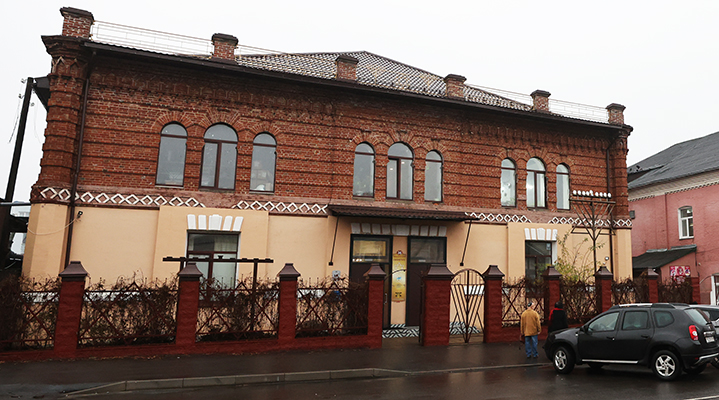
In the 19th century, Bobruisk was one of the centers of the spiritual life of Belarusian Jews. Local rabbis were known far beyond the borders of the country. At different times, the city was home to the leader of Chabad Hasidism Baruch Mordecai Ettinger, Hillel of Paritch, Shmaryahu Noach Schneerson, Yaakov David Wilovsky (Ridbaz) and Raphael Shapiro, afterward head of the Volozhin yeshivah. In the 20th century, there were 42 synagogues in the city, so Bobruisk was often called “the city of 40 synagogues", and Yiddish was spoken on the streets of Bobruisk even in the post-war years.
Now the only functioning Jewish temple in Bobruisk is a synagogue which is more than 100 years old. After the Great Patriotic War until the end of the 20th century, the Jewish community did not have a place for worship. The synagogue reopened after renovations in 2002, when Rabbi Shaul Hababo came to the city from Israel. The temple has the holy book of the Jews - the Torah - and a special ark for it. The synagogue conducts classes teaching the Torah, Jewish traditions and laws.
Address: 36 Sotsialisticheskaya Street
Jewish Courtyard
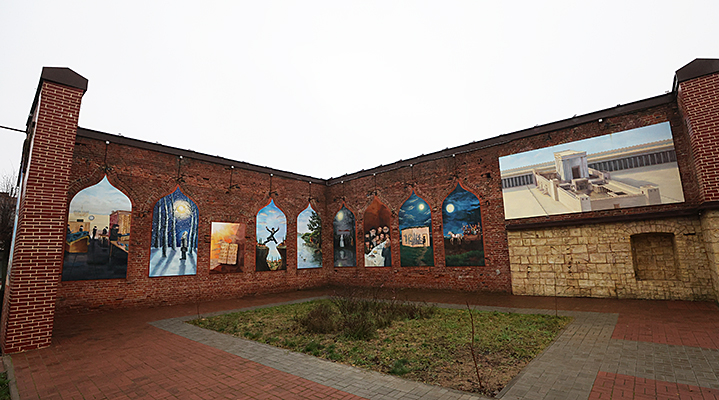
The Jewish courtyard in Bobruisk is a garden located along the two restored walls of the ancient synagogue. The idea of such a tourist location was suggested by Rabbi Shaul Hababo in 2015. About four years on the idea was realized. In August 2019, the grand opening of the courtyard-museum took place with the participation of community leaders, sponsors and parishioners. It has an atmosphere of peace: pedestrian paths, flower beds, a gazebo for cozy meetings. The walls are decorated with paintings by Yehiel Offner ‘about the everyday life and holidays of Jewish life’. It is expected that the courtyard will enter the tourist routes as a special complex incorporating a museum, a synagogue and a cafe.
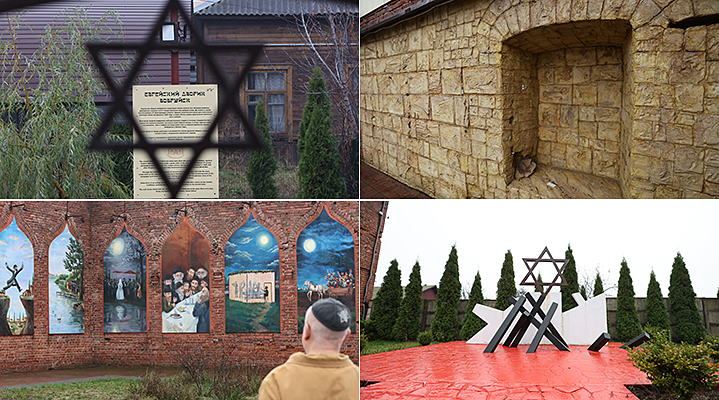
A memorial sign “From Life to Life” dedicated to the Holocaust victims and the renewal of Jewish communities was unveiled in the courtyard in June 2022. Each detail has a meaning: cutouts on the wall symbolize damage from shelling, black beams are a symbol of burnt houses and destroyed lives, and the Star of David means the revival of Jewish life. A brief history of Jewish communities and the story of their destruction is written on the wall.
Address: Intersection of Chongarskaya Street and Bakharova Street
Nepogodin Printing House
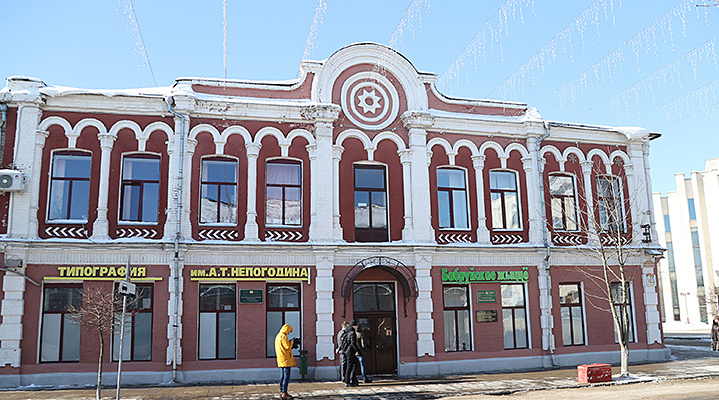
This printing house is one of the oldest in Belarus. All in all, there were six printing houses in the city at the end of the 19th century. The largest of them was founded in 1888 and was owned by merchant Kuld Friedland. In 1913, it employed 19 people and ‘its output was estimated at 12,000 rubles’.
The printing house received a new lease on life in 1918. It kept working during the Great Patriotic War when it was used by underground fighters. In 1968-1972 the printing house underwent reconstruction; a new building was erected there. During the Soviet times it was named after printer Aleksandr Nepogodin, a member of the communist underground movement that was active in Bobruisk during the Civil War and military intervention. Today it is a modern printing company offering a wide range of products, from packaging and labels to high-tech letterheads and securities.
The two-story Art Nouveau building of the printing house was built of brick in the early 20th century. It is decorated with pilasters and semi-columns, arched lintels and sill niches under windows. This is one of the most remarkable architectural specimens of Bobruisk.
Address: 103 Sotsialisticheskaya Street
Former Alekseevskaya Women’s Gymnasium
Slavic Gymnasium (Gymnasium No. 3 today) is one of the oldest educational institutions in Bobruisk. Part of it is located in the building of the former Alekseevskaya Women’s Gymnasium founded in 1906. It was named after Tsarevich Alexei, the son of Nicholas II. In those days, girls studied eight years in school and the curriculum included religion, geography, history, Russian, German, French and Latin, as well as needlework. The staff included graduates of St. Petersburg University and Vilna Higher School. Later, some of the premises were re-purposed to become the city’s first public library. Its fund was replenished by Natalia Vorontsova-Velyaminova, granddaughter of the famous Russian poet Alexander Pushkin. Her estate was located opposite the gymnasium (now the estate houses a civil registration office).
After the Great Patriotic War, Bobruisk Pedagogical School moved into the building of Alekseevskaya Gymnasium in 1944. Five years later it was renamed to become Bobruisk Teachers’ Institute. In 1965, a monument to military units that distinguished themselves during the liberation of Bobruisk from the Nazis was erected near the walls of the gymnasium. In the summer of 2005, Belarus’ first Alley of the Righteous among the Nations was laid nearby in honor of locals who saved Jewish families during the Second World War.
Address: 119 Sotsialisticheskaya Street
St. Nicholas Cathedral
Built in the Russian Retrospective style, St. Nicholas Cathedral is the oldest surviving temple in Bobruisk. Its construction began in 1892. The construction project was funded by the state treasury and parishioners. The consecration of the cathedral took place in 1894. Unfortunately, in Soviet times it shared the fate of many places of worship in the country. In the 1930s, a heavy copper bell was thrown from the belfry of the temple and, together with the crosses, was taken away for melting down. In 1965 a swimming pool opened in the cathedral that had been rebuilt beyond recognition. The 19th century frescoes on tiled columns and plastered walls were hidden for many years.
It was not until 2002 that the temple was returned to the parishioners and the reconstruction began in a bid to return the cathedral to its original state using old drawings. In 2007, the church bell tower was mounted with its spire rising 32 meters above the ground. The second consecration of the cathedral took place on 22 May 2007, Memory Day of St. Nicholas the Wonderworker. Today it is one of the largest churches in Mogilev Oblast, the center of the Bobruisk Orthodox eparchy. A sisterhood in honor of St. Equal-to-the-Apostles Nina was created at the cathedral. The sisterhood helps the disabled and elderly people.
Address: 76 Sovetskaya Street
Bobruisk Hotel
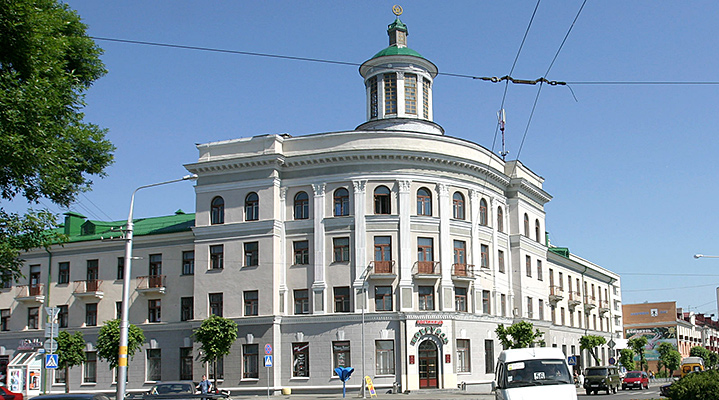
The Bobruisk Hotel is one of the most memorable locations for visitors. Built in the post-war period (1958), it elegantly emphasizes the curve of Sovetskaya Street leading to Lenin Square in the city center. The hotel itself has a unique location at the intersection of three streets of the old quarter – Romanovskaya Street, Borovaya Street and Nikolayevskaya Street. Today anyone can walk in, as the main building is used as office space. A vestibule, administrative and auxiliary premises are located on the ground floor. Each floor is decorated with Soviet-era sculptures. Now only the building erected on the side of Sovetskaya Street is used as a hotel.
Address: 97/26 Sovetskaya Street
Church of the Immaculate Conception of Blessed Virgin Mary
The construction of this Roman Catholic church began in 1901 under the guidance of priest Jan Krasovsky. The main altar of the church was consecrated by Metropolitan Archbishop of Mogilev Vincent Klyuchinsky on 9 September 1912. The neo-Gothic stone temple stood out in the architectural ensemble of the city. The four-sided tower crowned with a spire rose above the facade that was decorated with a jagged shield and sharp turrets. The interior design combined wood carvings, mosaics, stucco moldings, colored glass, metal products. The image of the Mother of God, a copy of a painting by the 17th-century Spanish artist Bartolome Esteban Murillo, was considered the gem of the temple.
The temple was shut down twice - in 1935-1941 and 1946-1955. In 1968, it forfeited its signature feature - a high traceried belfry. The building served as a museum, later it was an office of a construction trust. It was not until March 1996 that the altar part of the church was given back to the believers, the church was restored and its historical name was returned - the Church of the Immaculate Conception of Blessed Virgin Mary. Today, it is decorated with 14 bronze sculptures reproducing the Way of the Cross. The sculptures were made by Minsk sculptor Yevgeny Dobrovolsky.
Address: 121 Oktyabrskaya Street
Merchant Katznelson’s House
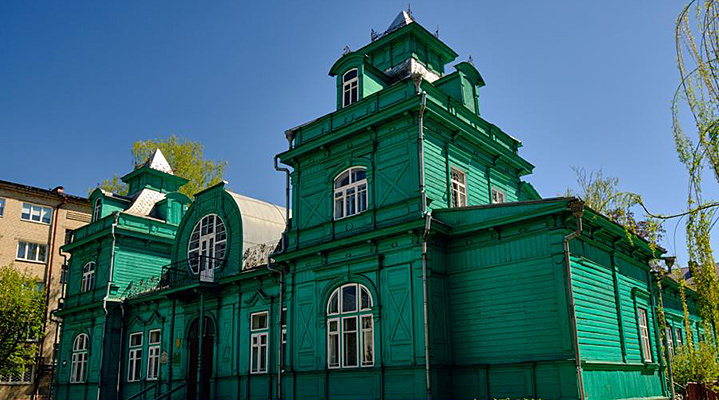
Undoubtedly, the most eye-catching building in the urban ensemble of Bobruisk is the bright turquoise wooden house of merchant Katznelson built in 1912 in the Art Nouveau style. Its owner, Paya-Brina Katznelson, was a timber trader. According to one version, the woman took a liking to a mansion in the Baltics. She bought it and had it taken apart and transported to Bobruisk. However, she did not live in the house for a long time, as she moved to St. Petersburg to join her son before the revolution. The mansion survived the war, its building was used as a municipal library from the 1970s until 2014. The new owner is expected to repair the building, return an original look to the facade, install lighting and open a street museum in the courtyard. The building itself will be used an as office.
Address: 25 Internatsionalnaya Street
Water tower-restaurant with observation deck
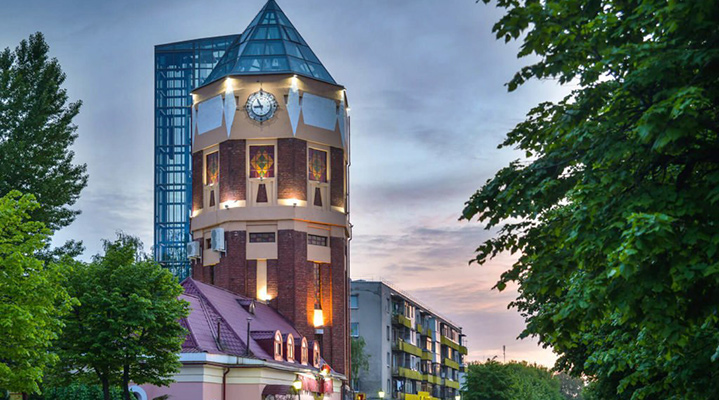
This monument of industrial architecture - a red brick tower, which supplied water to the whole city, was erected in Bobruisk in 1927. It was badly damaged during the Great Patriotic War. Later it was rebuilt and fulfilled its functions until 1960. After that the tower was used as a laboratory to control the quality of the city water. In 2003, the restored tower was turned into a restaurant called Chyrvonaya Vezha. Each of its floors has its own atmosphere: a cafe-bar, a billiard room, a hookah bar. The fifth floor is occupied by a restaurant under the glass pyramid dome. The place also has an observation deck with a beautiful view of the city. You can get up here not only by a spiral staircase but also use an elevator. Inside the tower, you can see an authentic water-pressure mechanism - a steel tank, which has become an element of the interior.
On the outside there is a large clock that strikes the time every hour and plays the famous tune Seven Forty at 7:40 pm. The weather vane is decorated with a jolly beaver holding the city's coat of arms.
Next to the tower-restaurant there is an index of cities and a monument to the literary character Shura Balaganov.
Address: 194 Pushkin Street
Former Mirenburg House
This big townhouse of the eclectic style is an architectural monument of the early 20th century. It was built in 1912 for the businessman Mirenburg, who was engaged in timber industry. A solid one-storey building with a four-slope metal roof boasts Classicism, Art Nouveau, and Empire features. The facade is decorated with massive columns featuring cannelures, moldings, and cornices, as well as floral patterns and images of harpies.
The house has preserved a rare collection of six tiled fireplaces from the time it was built. They are all different: three of them are red-green, two are white and golden, and one is dark coffee-colored, decorated with floral patterns and moths. Fireplace apertures are flanked by female figures - statues of caryatids - goddesses of forests and hunting Artemis.
Address: 211 Pushkin Street
Memorial to soldiers-liberators of Bobruisk
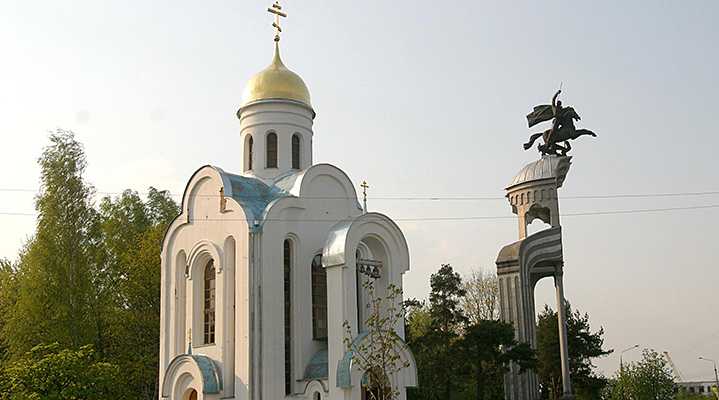
A memorial in honor of soldiers who died liberating the city from the German invaders in June 1944 was unveiled in Bobruisk on 3 July 1999. The art conception of the large-scale project was created by the famous Belarusian artist Eduard Agunovich.
In 1965 an obelisk and steles with the names of the heroes were installed at the common grave of the soldiers who died in the Bobruisk offensive operation. Two inclined plates were added to the monument in 1974, and four more in 1994. The reconstruction of the existing memorial compositions and the development of a single complex began in 1998.
The memorial resembles an open book, the pages of which immortalize the names of 938 fallen soldiers. The upper part of the composition is a pantheon in the form of a hemisphere with an arched entrance-gate. Ten pillars 21 meters high hold a horsed monument (5.5m) - the first one in Belarus. According to the idea of the sculptor Gennady Buralkin, St. George the Victorious sitting on the horseback in the uniform of a Soviet soldier thrusts a spear into an aspid serpent - the Nazi swastika.
Next to the memorial is the chapel of the icon of the Mother of God Joy of All Who Sorrow, built in 1999.
Address: Intersection of Minskaya Street and Krylov Street
Bobruisk Fortress
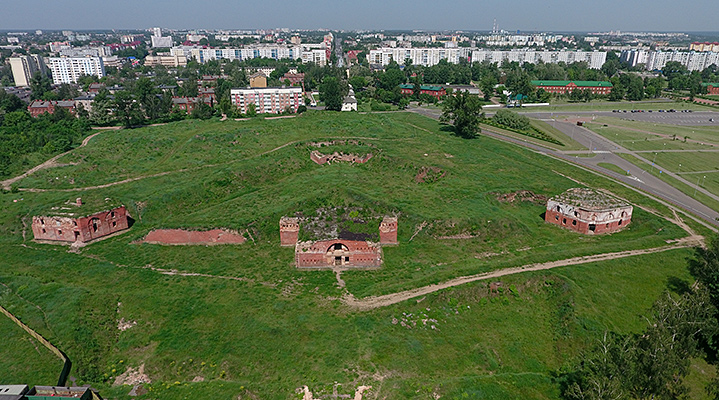
Bobruisk Fortress is a legendary landmark both in Belarus and entire Europe. Its history is connected with the events of the War of 1812, the Decembrist Movement and the Great Patriotic War. “The older sister” of the Brest Fortress was a unique defensive structure with the best military equipment in the second half of the 19th century.
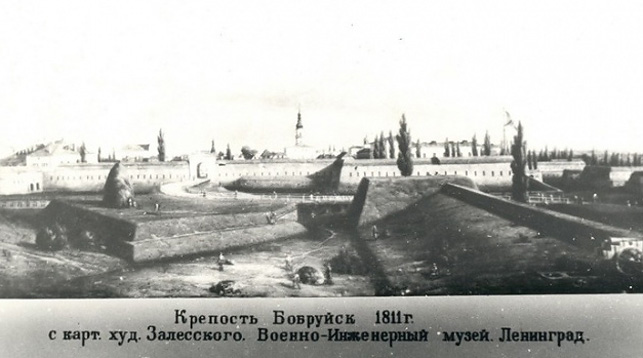
During the war of 1812 the garrison of the Bobruisk fortress faced Napoleon's army and after the retreat of the Russian troops held off the French siege for another four months. It was within these walls that members of the Southern Society of the Decembrists developed one of the first plans of the uprising - the famous Bobruisk Plan - to seize the fortress and overthrow Emperor Alexander I. According to the decision of the Supreme Criminal Court of 1823, 16 Decembrists out of 121 were sentenced to hard labor in the citadel. Among them were Sergei Muravyov-Apostol, Ivan Povalo-Shveikovsky, Vasily Norov, Mikhail Bestuzhev-Ryumin, Vasily Tizengausen.
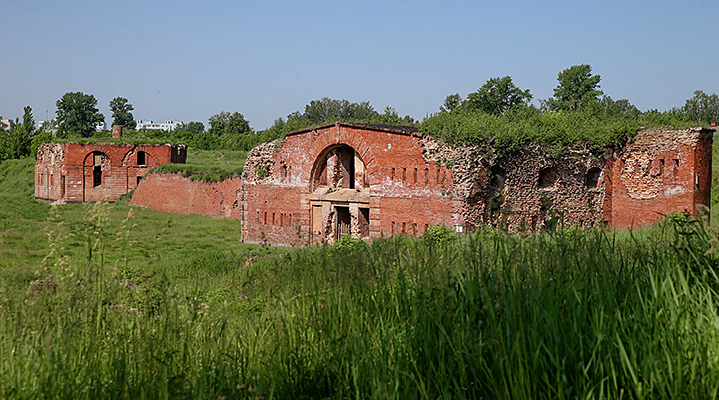
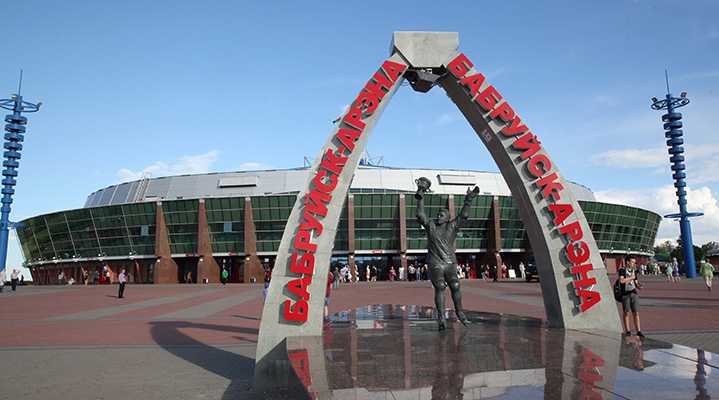
The city’s main event venue - Bobruisk Arena – has been built on the grounds of the former fortress. It hosts hockey tournaments and other sports events, concerts and shows, and is open to fans of outdoor activities.
Address: 11 Karbyshev Street
St. George's Church (White Church)
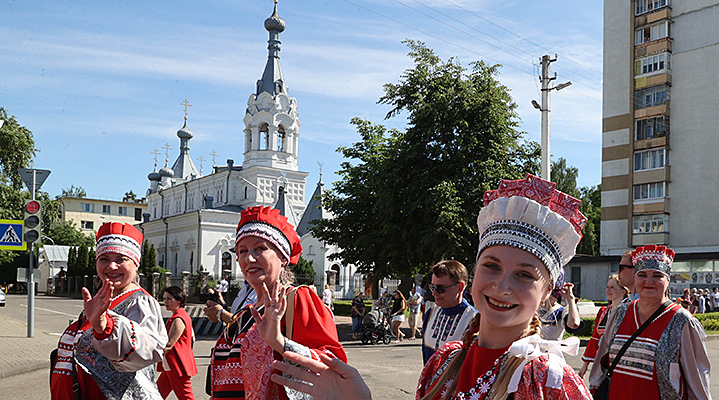
This beautiful stone church was built in 1905-1907 as a garrison church for soldiers of Bobruisk Fortress. The walls were painted white as a symbol of purity and cleanliness. It was called the White Church for this reason.
With the Soviet system coming to power in 1924 St. George's Church was closed. Later the bell tower and domes were destroyed, and for many years the building was used as a sewing shop, a warehouse, a machine shop during the German occupation, a canteen and a library. Only in 1990, the White Church was returned to the parishioners and once again became a functioning temple. The restoration of the historic bell tower had been completed by 1995.
Today it is a beautiful decoration of the city - a three-nave basilica in the Old Russian style. Inside there is a carved iconostasis with the faces of the saints - the work of specialists of the Moscow iconographic school.
Address: 4 Karbyshev Street
Lukovaya Gora Landscape Reserve
The picturesque natural site Lukovaya Gora is situated near the northern outskirts of the city on the right bank of the Berezina River. It is a favorite vacation spot of the Bobruisk residents and has been a landscape preserve of local importance since 1994. The site is 1000m long and 30,5ha big. The river-bed near the ancient village Luki (today the Berezina settlement) approaches a 30-meter steep slope. The terrain was formed some 300,000-250,000 years ago under the influence of water-glacial deposits of the Dnieper and Sozh glacials, when the ice cover spread over the whole territory of Belarus, reaching the south of the country.
Address: Pervomaisky district, between the 6th district of Bobruisk and the Berezina settlement
Church of St. Elijah the Prophet (St. Elijah's Church)
The Church of St. Elijah the Prophet - a monument of wooden architecture of the 19th century – is located on the grounds of the landscape reserve. The temple was moved to Bobruisk from the Kuleshovka village of Klimovichi District in 2004 but it was originally built in 1893.
The new place for it was not a random choice: there had been a church of Prophet Elijah near the Lukovaya Gora since the early 17th century. According to historians, around 1811 it was dismantled to build another church, the Church of St. Sophia, in the local cemetery.
This wooden building features a cubic main frame, a five-sided apse with small faceted sacristy, and a porch. There is an octahedral tholobate above the main part of the church and an octahedron of the bell tower, topped by a peaked roof above the porch. The treasure of the temple are the relics of venerable Fathers of Optina and the relics of St John of Korma.
Address: 38 Sikorsky Street


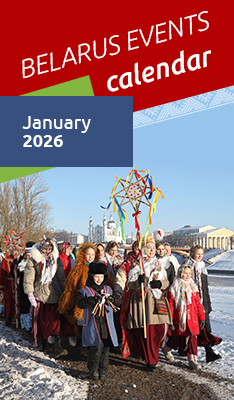




 print version
print version make home page
make home page add to bookmarks
add to bookmarks
